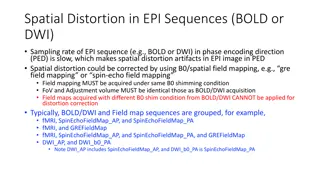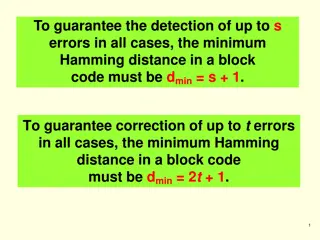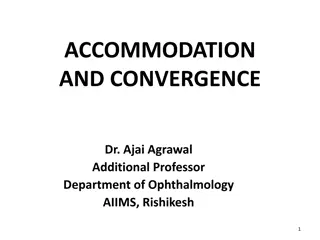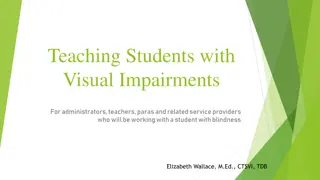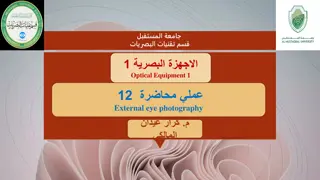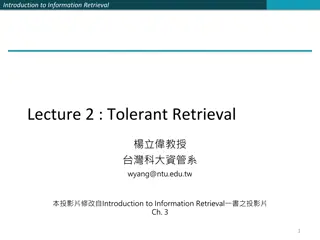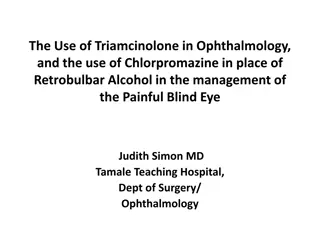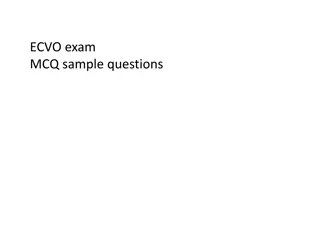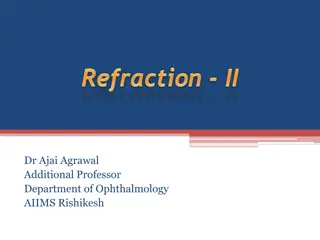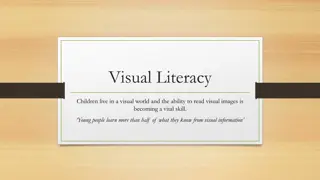Optimal Visual Correction in Ophthalmology
Providing optimal visual correction through the provision of spectacles in ophthalmology requires a blend of science and art. Ophthalmologists must possess knowledge and clinical experience to ensure each patient receives the best visual correction. Various concepts such as ametropia, optical corrections, lens conjugacy, and the role of corrective lenses in achieving optimal visual outcomes are explored in this informative content.
Download Presentation

Please find below an Image/Link to download the presentation.
The content on the website is provided AS IS for your information and personal use only. It may not be sold, licensed, or shared on other websites without obtaining consent from the author.If you encounter any issues during the download, it is possible that the publisher has removed the file from their server.
You are allowed to download the files provided on this website for personal or commercial use, subject to the condition that they are used lawfully. All files are the property of their respective owners.
The content on the website is provided AS IS for your information and personal use only. It may not be sold, licensed, or shared on other websites without obtaining consent from the author.
E N D
Presentation Transcript
Gamal Gamal Abdellatief Abdellatief Radwan Radwan, , MD MD
The provision of spectacles to correct vision is based on both science and art so every ophthalmologist should be armed with knowledge and supplemented by clinical experience to attain competency in providing optimal visual correction for each patient The provision of spectacles to correct vision is based on both science and art so every ophthalmologist should be armed with knowledge and supplemented by clinical experience to attain competency in providing optimal visual correction for each patient
1) Object / Image ametropic 2) Far point and optical corrections. 3) Lens effectivity 4) Effect of changing lens position Object / Image conjugacy ametropic eyes. 2) Far point and optical corrections. 3) Lens 4) Effect of changing lens position conjugacy in eyes. in 1) effectivity. .
An object and the image of that object created by an optical system are said to be conjugate to one another
If the retina of an eye is thought of as an object, the image of the retina created by the eye's optical system will be located at the far point plane. The far point denotes the location at which the far point plane intersects the optical axis. That point is conjugate to the fovea by any non accommodating eye.
Almost any lens can become a corrective lens if its secondary focal plane is placed to coincide with the ametropic eye's far point plane
If a given corrective lens is moved along the visual axis, its effectivity is changed that means the image of a distant object created by the lens will no longer be coincident with the far point, which is fixed in position relative to the eye and so will result in blurring of retinal image.
+ +12 12 Far point Far point 14 mm 14 mm Far point Far point 83 83mm mm- -14 14mm= mm=69 69mm mm 1 1\ \69 69=+ =+14 14
1. Basic optics. 2. Full versus partial correction. Basic optics. Full versus partial correction. 1. 2.
The far point plane of the myope is located at a certain plane in the front of the eye and determine the degree of myopia. For the myope, all objects located further away from the far point plane will result in blurred retinal imagery. (For example 1 D myopia). By definition, the lens that corrects a given degree of myopia images an object at the far point plane of the eye.
To create a truly clear retinal image of a distant object, the full extent of myopia must be corrected. However several issues need to be considered: 1. Length of the examination room. 2. Night myopia. 3. Visual needs of the patient. 4. Corrected before or not. 1. Length of the examination room. 2. Night myopia. 3. Visual needs of the patient. 4. Corrected before or not.
1) Basic optics. 2) Full versus partial correction. Basic optics. Full versus partial correction. 1) 2)
The far point of the located behind the eye and so it is virtual. A lens is corrective if its focal point coincides with the far point of the The far point of the hypermetropic located behind the eye and so it is virtual. A lens is corrective if its focal point coincides with the far point of the hypermetrope hypermetropic eye is eye is hypermetrope. .
Depends on: 1. Patient age. 2. Degree of hyperopia. 3. Accomodation and binocular status. Depends on:- - 1. Patient age. 2. Degree of hyperopia. 3. Accomodation and binocular status.
1) Basic optics. 2) Full versus partial correction. Basic optics. Full versus partial correction. 1) 2)
The astigmatic eye is unique in that it has two far points planes, one for each of the two principle meridians of thee refractive error. Any object point complex bowtie shaped image ( Strum) with waste called circle of least confusion. The astigmatic eye is unique in that it has two far points planes, one for each of the two principle meridians of thee refractive error. Any object point complex bowtie shaped image (Conoid Strum) with waste called circle of least confusion. Conoid of of
For correction, cylindrical lenses are used, in compound and mixed astigmatism, spherocylindrical equivalent of that lens is the spherical power that is dioptrically halfway between the highest and lowest of the principle With the rule or against the rule. Cannot achieve perfect retinal clarity by holding an object at any single position, as in myope presbyope So the aim is to produce sharp retinal imagery. For correction, cylindrical lenses are used, in compound and mixed astigmatism, spherocylindrical is used. With spherical equivalent of that lens is the spherical power that is dioptrically halfway between the highest and lowest of the principle meridia With the rule or against the rule. Cannot achieve perfect retinal clarity by holding an object at any single position, as in myope or can use accommodation as in presbyope. . So the aim is to produce sharp retinal imagery. is used. With spherical meridia powers. powers. or can use accommodation as in
Visual correction of the as clear cut as Spherocylinder minification orientation and The patient may adapt and if not maintain the spherical equivalent is used and reduce the amount of cylinder. Visual correction of the astigmate as clear cut as myope Spherocylinder produce magnification or minification orientation and athenopia The patient may adapt and if not maintain the spherical equivalent is used and reduce the amount of cylinder. astigmate is not often myope or produce magnification or disturbance in spatial athenopia. . is not often or hyperope hyperope. . disturbance in spatial
You should always consider how that refractive correction may affect the accommodative function of each patient, especially those with accommodative dysfunction or those with early or established presbyopia: Myopes. Hyperopes.
Esophoric and esotropic patients. Exophoric and exotropic.





